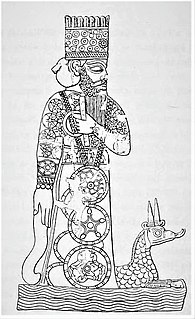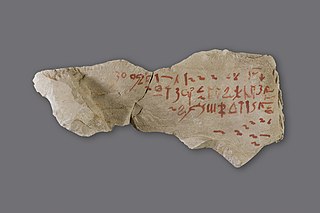Related Research Articles

Chaldea was a country that existed between the late 10th or early 9th and mid-6th centuries BCE, after which the country and its people were absorbed and assimilated into Babylonia. Semitic-speaking, it was located in the marshy land of the far southeastern corner of Mesopotamia and briefly came to rule Babylon. The Hebrew Bible uses the term כשדים (Kaśdim) and this is translated as Chaldaeans in the Greek Old Testament, although there is some dispute as to whether Kasdim in fact means Chaldean or refers to the south Mesopotamian Kaldu.

Babylonia was an ancient Akkadian-speaking state and cultural area based in central-southern Mesopotamia. A small Amorite-ruled state emerged in 1894 BCE, which contained the minor administrative town of Babylon. It was merely a small provincial town during the Akkadian Empire but greatly expanded during the reign of Hammurabi in the first half of the 18th century BCE and became a major capital city. During the reign of Hammurabi and afterwards, Babylonia was called "the country of Akkad", a deliberate archaism in reference to the previous glory of the Akkadian Empire.

The Babylonian captivity or Babylonian exile is the period in Jewish history during which a number of people from the ancient Kingdom of Judah were captives in Babylon, the capital of the Neo-Babylonian Empire.

Necho II of Egypt was a king of the 26th Dynasty, which ruled out of Saite. Necho undertook a number of construction projects across his kingdom. In his reign, according to the Greek historian Herodotus, Necho II sent out an expedition of Phoenicians, which in three years sailed from the Red Sea around Africa to the Strait of Gibraltar and back to Egypt. His son, Psammetichus II, upon succession may have removed Necho's name from monuments.

Mesopotamian religion refers to the religious beliefs and practices of the civilizations of ancient Mesopotamia, particularly Sumer, Akkad, Assyria and Babylonia between circa 3500 BC and 400 AD, after which they largely gave way to Syriac Christianity. The religious development of Mesopotamia and Mesopotamian culture in general was not particularly influenced by the movements of the various peoples into and throughout the area, particularly the south. Rather, Mesopotamian religion was a consistent and coherent tradition which adapted to the internal needs of its adherents over millennia of development.

The Enūma Eliš is the Babylonian creation myth. It was recovered by English archaeologist Austen Henry Layard in 1849 in the ruined Library of Ashurbanipal at Nineveh. A form of the myth was first published by English Assyriologist George Smith in 1876; active research and further excavations led to near completion of the texts and improved translation.

The Rev. Archibald Henry Sayce, was a pioneer British Assyriologist and linguist, who held a chair as Professor of Assyriology at the University of Oxford from 1891 to 1919. He was able to write in at least twenty ancient and modern languages, and was known for his emphasis on the importance of archaeological and monumental evidence in linguistic research. He was a contributor to articles in the 9th, 10th and 11th editions of the Encyclopædia Britannica.

Josiah or Yoshiyahu was the sixteenth king of Judah who, according to the Hebrew Bible, instituted major religious reforms. Josiah is credited by most biblical scholars with having established or compiled important Hebrew scriptures during the "Deuteronomic reform" which probably occurred during his rule. Josiah became king of the Kingdom of Judah at the age of eight, after the assassination of his father, King Amon. Josiah reigned for thirty-one years, from 641/640 to 610/609 BCE.
Mar Awgin or Awgen, also known as Awgin of Clysma or Saint Eugenios, was an Egyptian monk who, according to traditional accounts, introduced Christian monasticism to Syriac Christianity. These accounts, however, are all of late origin and often contain anachronisms. The historicity of Awgin is not certain.

Sir Ernest Alfred Thompson Wallis Budge was an English Egyptologist, Orientalist, and philologist who worked for the British Museum and published numerous works on the ancient Near East. He made numerous trips to Egypt and the Sudan on behalf of the British Museum to buy antiquities, and helped it build its collection of cuneiform tablets, manuscripts, and papyri. He published many books on Egyptology, helping to bring the findings to larger audiences. In 1920, he was knighted for his service to Egyptology and the British Museum.

Rolf Johan Furuli is a professor emeritus in Semitic languages at the University of Oslo; he retired in 2011.
The Hibbert Lectures are an annual series of non-sectarian lectures on theological issues. They are sponsored by the Hibbert Trust, which was founded in 1847 by the Unitarian Robert Hibbert with a goal to uphold "the unfettered exercise of private judgement in matters of religion.". In recent years the lectures have been broadcast by the BBC.
Henry Reginald Holland Hall MBE, FBA, FSA was an English Egyptologist and historian. In life, he was normally referred to as Harry Reginald Hall.

Instruction of Amenemope is a literary work composed in Ancient Egypt, most likely during the Ramesside Period ; it contains thirty chapters of advice for successful living, ostensibly written by the scribe Amenemope son of Kanakht as a legacy for his son. A characteristic product of the New Kingdom “Age of Personal Piety”, the work reflects on the inner qualities, attitudes, and behaviors required for a happy life in the face of increasingly difficult social and economic circumstances. It is widely regarded as one of the masterpieces of ancient near-eastern wisdom literature and has been of particular interest to modern scholars because of its relationship to the biblical Book of Proverbs.

Babylon was the capital city of the ancient Babylonian empire, which itself is a term referring to either of two separate empires in the Mesopotamian area in antiquity. These two empires achieved regional dominance between the 19th and 15th centuries BC, and again between the 7th and 6th centuries BC. The city, built along both banks of the Euphrates river, had steep embankments to contain the river's seasonal floods. The earliest known mention of Babylon as a small town appears on a clay tablet from the reign of Sargon of Akkad of the Akkadian Empire. The site of the ancient city lies just south of present-day Baghdad. The last known record of habitation of the town dates from the 10th century AD, when it was referred to as the small village of Babel.

The Bible and Orient Museum in Fribourg, Switzerland is the exhibition of a collection of ancient Egyptian and ancient Near Eastern miniature art, as well as a project to create a modern museum to compare biblical and extra-biblical texts with archaeological, epigraphical and iconographical data. This comparison is aimed at offering stimulating insights for the advancement of the interreligious dialog.
The House of Egibi was a family from within ancient Babylonia who were, amongst other things, involved in mercantile activities.
The earliest known precursor to Hebrew is an inscription in Ancient Hebrew is the Khirbet Qeiyafa Inscription, if it can indeed be considered Hebrew at that early a stage. By far the most varied, extensive and historically significant body of literature written in the old Classical Hebrew is the canon of the Hebrew Bible, but certain other works have survived as well. It was not unusual for ancient narratives, poetry and rules to have been transmitted orally for several generations before being committed to writing. Before the Aramaic-derived modern Hebrew alphabet was adopted circa the 5th century BCE, the Phoenician-derived Paleo-Hebrew script was used instead for writing, and a derivative of the script still survives to this day in the form of the Samaritan script.

The cuneiform an sign,, is a common, multi-use sign, a syllabic for an, and an alphabetic sign used for a, or n; it is common in both the Epic of Gilgamesh over hundreds of years, and the 1350 BC Amarna letters, and other cuneiform texts. It is also used for the designation of a "god", and is sometimes represented as a superscript: d, or capitalized: D, for "dingir", English language, "god". The example photo at right shows, a list of 14 named gods, all with "an"; the first pair on the list AN-UTU, or DUTU, refers to the "sun-god", using Ud (cuneiform), as the sumerogram, namely UTU.
References
- ↑ Gillespie, C. G. K. (1894). "By-paths of Bible Knowledge (advertisement)". The sanitary code of the Pentateuch. pp. 97–98.
- ↑ "By-paths of Bible Knowledge". The Old Testament Student. 4 (1): 44–45. September 1884. (This book review erroneously refers to "Mr. Harkness".)
- ↑ By-paths of Bible Knowledge. London: Religious Tract Society.
- 1 2 Two different volumes in the series were assigned the number 5.